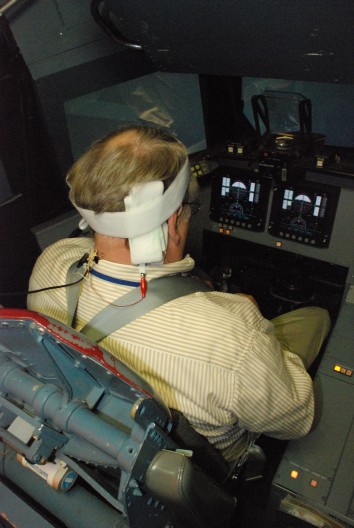Via Gizma

There are airplanes and swimming pools that give prospective astronauts a taste of what a zero-gravity environment will feel like, but the sensations that they will feel upon returning from such an environment are also important to simulate. Astronauts coming back to Earth’s gravity often experience disturbances in their vision and neurological function, to the point that they can have trouble walking, keeping their balance, or even safely landing their spacecraft. By utilizing a Galvanic vestibular stimulation (GVS) system, however, scientists can give them a sneak peek of what to expect, so they can better compensate for it when it happens in the field.
The system was developed by Dr. Steven Moore of the National Space Biomedical Research Institute (NSBRI). It consists of a small box, which sends a 5 milliamp current to electrodes placed behind the subjects’ ears. Those electrodes deliver electricity through the skin to the vestibular nerve, which in turn sends signals to the brain that result in sensorimotor disturbances. Because the box is portable, subjects can carry it with them while attempting to walk – no doubt a big hit at the NSBRI’s office parties.
Moore tried his system out on 12 test subjects at the NASA Ames Research Center in Moffett Field, California. Each subject flew 16 simulated shuttle landings, half of those landings with the GVS and half without. He compared the results to data collected from over 100 shuttle landings. Subjects using the GVS, he concluded, experienced disturbances similar to those experienced by shuttle pilots on actual flights.
Without the GVS, subjects tended to land the shuttle at a simulated speed of 204 knots, which is right on target. With the GVS, the average speed increased to around 210 knots, which is at the upper limit of the safety zone. Likewise, GVS-using subjects also had more difficulty performing a routine landing approach braking maneuver that required them to bring the craft from a 20-degree glideslope angle to a 1.5-degree angle. This is a point in real shuttle flights at which pilots often experience sensorimotor disturbances.
Moore stated that his system could be used as an analog for other space vehicles and operations, and that it could even be used to prepare people with vestibular disorders for the effects following surgery. The NSBRI research team is now trying to determine if people can adapt to the effects of the GVS over multiple sessions.


